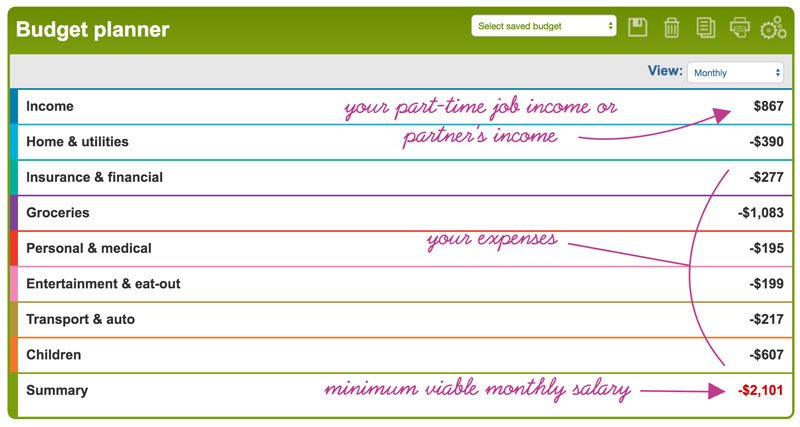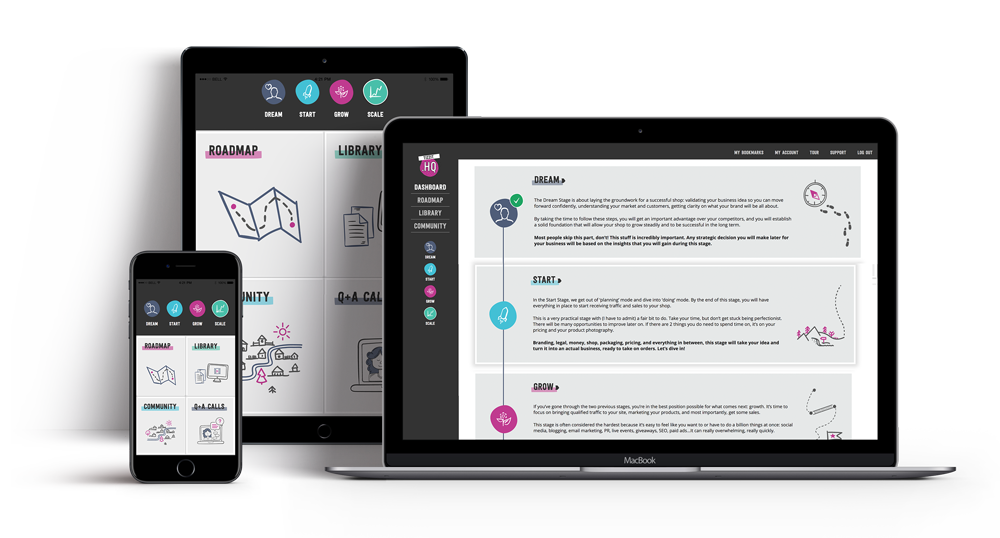from dream to handmade biz
Lesson 5 – handmade business costs
lesson outline
How much money do you need to make a month to live ?
How much does running a business cost you?
Your fixed costs
Your variable costs
Labor costs / What your time is worth
lesson resources
- Your Minimum Viable Salary Worksheet – Download
- Or alternatively this Online Budget Planner
- The Accounting Cheat Sheet – Your Costs
lesson checklist
- I know how much money I need to be making a month to live (my personal salary);
- I understand what are my fixed costs and have calculated them (my overhead);
- I have calculated my variable costs (Cost of Goods Sold);
- I have defined an hourly rate for the time spent creating my products;
- I estimated accurately the time I spend on average making my products and therefore have a clear idea of how much each product costs in labor.
need more help?
check out tizzit hq

WHEN YOU BECOME A MEMBER, YOU GET ACCESS TO:
- The 4-stage Maker’s Roadmap system: an interactive, step-by-step guide to all the fundamental steps you need to take (and in what order!) to build a successful handmade shop
- 20+ in-depth courses and guest expert workshops (and more added monthly!)
Live Monthly Q&A Sessions - A friendly and supporting community of like-minded makers for you to connect with and get feedback from
- And so much more: accountability, quick wins videos and tutorials, workbooks and checklists, etc.
How much money do you need to make a month to live ?
If you want to turn your handmade hobby into a full-time gig, the big question always is: when will I be able to sustain myself (and my family) with my shop?”. You might be working another job and wondering how you’ll know it’s time to quit it and focus on your handmade business exclusively? Or you might just wonder how many sales you’ll have to make per month to reach some sort of financial stability (meaning there’s food on the table and you can pay the bills with what you sell in your handmade shop). That’s exactly what we are going to tap into today and in a couple of days in Lesson 7 (“your profit plan”).
To start, you have to get clarity on exactly how much a month you need to live.
In a way that has nothing to do with your business itself; but at the same time it has everything to do with it because that’s what you need to “take-home” i.e the amount you need to make with your handmade biz to go full-time with it.
So the first thing I’d like you to do today is spend some time looking into your past bank statements and writing down on average on much you spend and on what each month.
If making a living from your handmade shop is a time-sensitive issue to you, this is a great time to reflect on what you really need (groceries) vs what you could skip and save instead (netflix?).
I call this amount your minimum viable monthly salary. This is what you have to pay minus what other income you might have (your partner/husband’s income, etc.)
Minimum Viable Monthly Salary = The amount you need to make in profit with your shop to be able to make a living off it.
It is = Total monthly expenses – Other household incomes you might have
I recommend you use this great budgeting tool to help you with it (it’s made by the Australian Government but really you can use it even if you live in the Netherland). It helps you think of expenses you might not have thought of and calculates everything for you.
You can input all your numbers in this online tool and the number in red at the bottom is your “minimum viable monthly salary”.
Alternatively, I have created a worksheet where you can do you your budgeting yourself.
Your pick, but take the time to do this!
It might not make much sense for you right now but in a couple of days (lesson 7) this will all come together and make so much sense! It will help you know exactly how many products you need to make each month, how many sales you need to make, and if your business idea is viable. That is some great insight! So do your homework 

How much does running a business cost you?
Your fixed costs
The first thing you need to be clear on is how much does running your handmade business cost you even if you’re not making one single sale that month.
These costs are called fixed costs because they do not vary according to the numbers of sales you make. In other words, no matter how many products you make or sell on any given month, there will be expenses that you have to pay no matter what. These are your fixed business costs or costs that you have to pay to operate your business.
Another word for it that you might have seen or heard before is overhead.
Fixed costs = Overhead = Operating costs
Fixed costs (or overhead) include things like your studio rent, insurance, monthly plan for your website (hosting or shopify fee for example), office supplies, travel expenses to participate in markets and craft fairs (fuel, hotel, etc.), social media tools (hootsuite, etc.), shipping software, accounting and bookkeeping software or fees, etc.
Your variable costs
Variable costs are costs that vary depending on your production volume. The more products you make and sell, the more you will have to pay in variable costs. This is because these costs are directly related to the product creation process.
Another word for variable costs that you could have seen or heard of is Cost of Goods Sold or COGS. This sounds complicated but don’t worry, it isn’t. It’s just a fancy word that accountants love to use to say “variable costs”.
Variable costs = Cost of goods sold = COGS
The reason for it is simple:
If every time you make and sell a product, your variable costs increase, it is like saying that there is a cost to selling this product: something that adds up to your fixed costs and that you wouldn’t have had to pay if you didn’t make and sell that product.
For that reason, variable costs are called “cost of goods sold” or in plain english “what it costs you to sell your products”.
Variable costs include things like: shipping and packaging costs for each product, and raw materials and supplies needed to create your products.
You can also include to your variable costs a percentage of loss for damaged supplies you received and couldn’t use; or for pieces that you won’t be able to sell after all because of a defect that came up during the creation process.
Labor costs / What your time is worth
Lastly, it’s important to understand how to account for labor costs.
As a maker, you spend a lot of time actually making your products, and you need to pay yourself for that time. You have to account for it.
Your labor costs are:
Time spent creating a product X Your hourly wage. It will be different for each product.
Labor costs are overlooked by most handmade business owners because it can be hard to know exactly how much time you spend creating each product. But it is crucial to your business as this will affect your pricing strategy, and ultimately your profit. Don’t make the same mistake and run a test: create the same product 5 times and record how long it takes you on average.
Once you know how long it takes you to create a product, you will get a clear idea of how much it costs you in labor costs to produce that item.
Eg.: You can make a cushion cover in 30 mins and you have an hourly rate of $15: the cost of labor for this one cushion is $7.5.
NB: if you follow the logic of variables VS fixed costs that I explained above, then you will want to add your labor costs to your variable costs. After all, the more products you sell, the more time you spend producing them, the more you should be remunerated right? Well…no. I know it is counterintuitive to what I just told you about variables costs (COGS) but do not incorporate your labor cost in your variable costs. Keep them separate.
Enough theory, let’s get to the nitty gritty! You know me…I love a good workbook and simple, step-by-step exercises, so this is exactly what I created for this lesson.
Download the PDF from today’s resources and you will have calculated your overhead, COGS and cost of labor per product in no time!
WOW. That was a BIG lesson. I am so proud of you for making it so far and dealing with your numbers early on so you can build a solid base for a profitable handmade shop. I hate numbers too, but isn’t understanding what exactly is going on with them so relieving in a way?
I hope you found today’s lesson useful. You’ve got this!
Don’t forget to check your emails tomorrow for Lesson 6 (already!) where we will price your handmade products, once and for all
